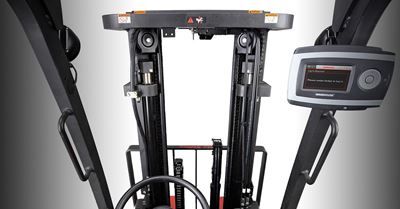Using telematics to right-size your lift truck fleet

Telematics systems can help you right-size your lift truck fleet, as well as zero in on exactly what types of trucks you’ll need to maximize efficiency
Figuring out how many lift trucks – or what kinds – you'll need for different areas of your operation is not an easy task. While one operator may spend the majority of the day using a single sit/stand reach truck, another may switch from a walkie pallet truck to a rider pallet truck several times throughout the day. If that wasn't enough, there are a plethora of truck types to choose from, ranging from swing reach trucks to order pickers, high-capacity reach-fork trucks to deep-reach lift trucks, or a combination of the two. It's like a never-ending 3D puzzle, and it's up to you to figure out how to put it all together.
Fortunately, guesswork is no longer required in this type of decision-making. Knowledge is the key to solving the puzzle, and with today's technological advancements, obtaining real-time information about your fleet and operators is becoming much easier. Telematics systems are a key innovation in the manufacturing and supply chain industries. These systems can provide detailed lift truck data to aid in fleet management and operator behavior monitoring. They can also provide you with the data you need to make better fleet decisions.
A properly sized and typed fleet can boost productivity and efficiency, and telematics systems can help determine which trucks are working the hardest and, based on usage data, which trucks should be removed from the fleet. You can make informed decisions about how to better meet operator needs or replace lift trucks if data shows that certain trucks aren't being used enough to justify their maintenance costs, or have reached an age where they require a lot of downtime for maintenance.
Here's a real world example of how a telematics system can save you money:
One customer was able to reliably predict slow and peak operations times after several months of collecting telematics data. Using the data, the company downsized its fleet from 76 to 67 trucks, eliminating one counterbalance forklift, one order-picker, three pallet jacks, and three swing-reach trucks. The telematics system monthly fee, truck maintenance, and staffing expenses were all saved by reducing its equipment by 12%, resulting in a $72,000 cost savings.
Telematics systems also provide data aggregation, which can reveal patterns of inefficiency in equipment. This data reveals how a specific type of lift truck can be underutilized or not used at all in your operation. With this information, you can better determine what types of lift trucks you'll need to complete your fleet.
Another area where telematics systems can assist with fleet right-sizing is determining whether it’s more advantageous to rent or buy equipment. Telematics systems track peak operations seasons and can predict when you'll need more equipment. For example, data from telematics systems helped the above company realize it had nine rental trucks it didn't need for the majority of the year, allowing the company to cut costs. Finally, right-sizing your fleet to meet daily needs and renting equipment as needed will save you money on maintenance, operator, and truck costs.
The potential of telematics systems goes far beyond right-sizing and right-typing your fleet. They can help you get a better overall view of your operation's many moving parts and piece the puzzle together for optimal performance.

